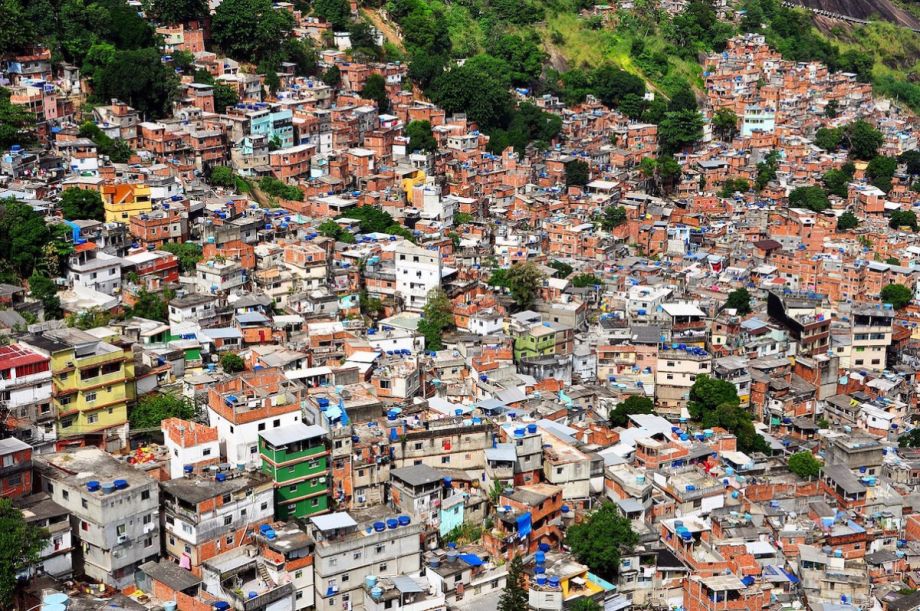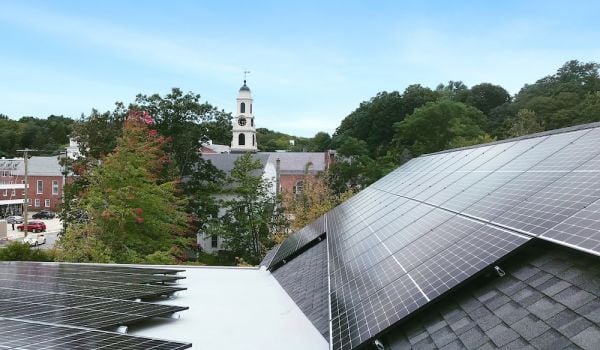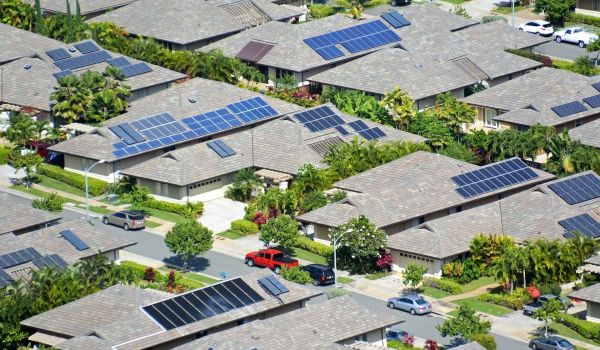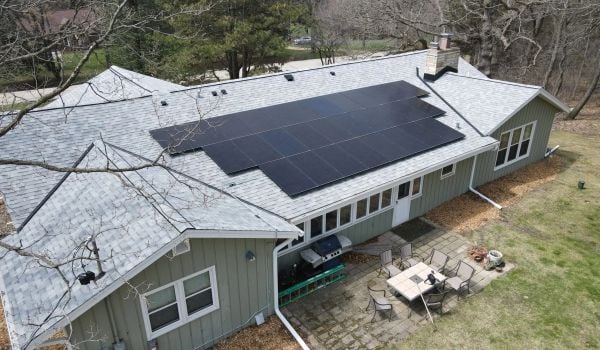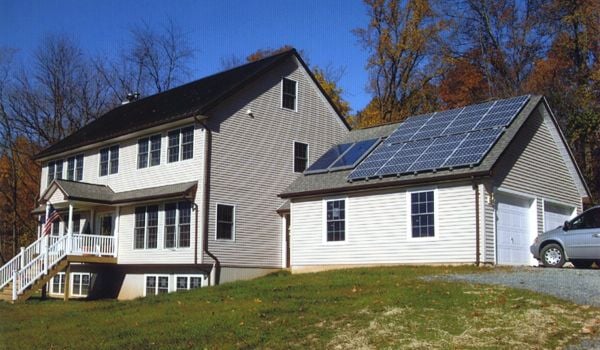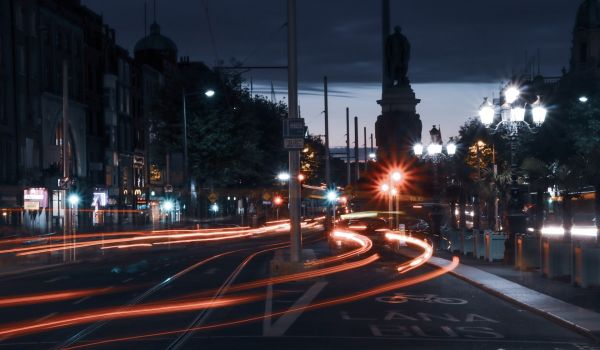In September, as a heat wave pushed temperatures in Brazil to record heights, a few dozen volunteers in yellow and blue hard hats carefully installed a rectangular array of panels onto the roof of a two-story building an hour outside of Rio de Janeiro.
The solar array will help power a vital community center in the Dique da Vila Alzira favela. The informal urban enclave, one of nearly 1,000 in Greater Rio de Janeiro, has so far satisfied its energy needs through DIY cabling, rigged to siphon energy from one of the region’s large energy companies. Without doing so, residents in many neglected favelas would otherwise be unable to pay the high utility costs.
While no housing in Dique da Vila Alzira is solar-powered, the community center’s staff hope that this project will prove — to outside funders as well as to neighbors in the favela — that solar energy can be expanded to neighboring homes.
Residents in favelas are typically without government support or legal claims to the land they live on. Even if the government doesn’t provide services, it can legally raze and bulldoze informal settlements — as happened prior to the 2016 Olympics, when thousands of people were displaced.
To Nill Santos, the community leader who founded this center, the benefits are solar are obvious: not only would the solar installation training provide job opportunities for some of her neighbors, “I can have savings for my institution and work for the environment at the same time,” she tells Next City in Portuguese through an interpreter.
The nonprofit Santos founded is called Associacáo De Mulheres De Atitude E Compromisso Social, or the Association of Women with Attitude and Social Commitment (AMAC for short). Santos, a survivor of domestic violence, founded it to provide social support to women. But AMAC is now a comprehensive cultural center with classes for children and young adults as well as a member of the Sustainable Favela Network, a larger network of favela-based groups sharing information and best practices on sustainable energy.
That network is how Santos learned about a grant that would allow favela leaders to be trained as “solar ambassadors,” and an opportunity for local residents to be trained in solar installation by a nonprofit called Solarize, with the assistance and knowledge sharing of members from another Rio favela, called Babilônia.
Energy needs in favelas
The Sustainable Favela Network’s survey of more than 1,100 people across 15 favelas paints a stark picture of the ongoing energy needs.
According to the “Energy Efficiency in Favelas” report, released in December 2022, the average per capita income for a respondent’s household is the equivalent of $85 a month. About 31% of families surveyed live in “energy poverty,” meaning that over 10% of their monthly income goes toward electricity.
There are also clear connections between energy costs and food insecurity: Almost 70% of those interviewed said that if their energy bill were halved, they would use the extra money to buy food. Those who made less than the minimum wage were disproportionately likely to suffer from blackouts and service cuts, which can cause food to spoil quickly.
The report also found that informal (and often illegal) energy hookups — referred to as “gatos” — are acts of economic necessity for people in the lowest income brackets. Nearly 70% of those interviewed said they knew someone with such a hookup. People earning less than half the minimum wage were the most likely to be siphoning energy.
Those informal connections are so common that utility companies factor them into their costs, calling them “non-technical losses” and raising prices on other customers to cover their losses. This, in turn, leads to resentment against favelas from higher-income Brazilians.
Yet 97% of households are also connected to the informal electricity grid. The report suggests that some households are paying energy companies for some of their energy while siphoning energy for certain appliances.
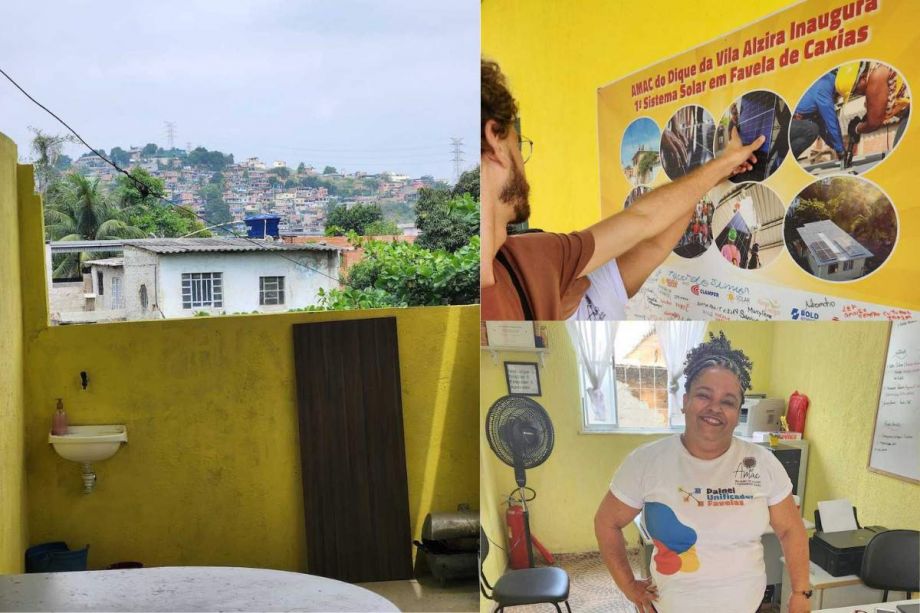
Photos by Roshan Abraham
In some cases, people report wanting to pay for a connection, but the utility refuses to come to their neighborhood for safety reasons. (Some favelas around Rio de Janeiro are controlled by drug gangs.)
“Most people are not paying their electric bill, not by choice, but because they can’t afford it. And the people who are paying it, sometimes are paying exorbitant prices,” says Theresa Williamson, founder of Catalytic Communities (CatComm), which facilitates the Sustainable Favela Network and the energy report.
The solar panels don’t allow units in favelas to be totally self-sufficient — the cost of running solar on a micro-grid, or a self-sufficient and closed system, is still prohibitively high.
In the U.S., solar micro-grids are becoming more popular among homeowners who want to be shielded from power outages brought about by large storms which have become more frequent as a result of climate change. But they are more likely to be deployed by affluent communities because of the cost of power storage.
So solar units in favelas typically plug into the existing energy grid. But because buildings are powered by a mix of free solar energy and power from the utility, the overall costs are lower. Any excess energy goes back into the wider system. Williamson says this could help formalize energy systems in favelas.
“If people were able to have solar at scale, then they would be contributing to the grid rather than taking from it. And so they could be a part of the system,” she says. “They can dramatically reduce their costs.”
One of the first favelas in Rio to implement solar was Babilônia, a dense mountain favela on a hill overlooking the Copacabana beach, where thousands of tourists crowd the sand every day. About 20 homes there are outfitted with solar panels; all of them function as a cooperative and share the energy. That cooperative formed in 2015 as a nonprofit, Revolusolar, which has been conducting trainings for the Sustainable Favela Network, including at AMAC. Revolusolar has taken a leadership role within the Solar Favela Network, providing courses on solar energy and climate justice, including a weekly course that convened last June and commenced with the solar installation at AMAC.
Sustainable Favela Network and AMAC
The Sustainable Favela Network was convened by CatComm after the Rio+20 Environmental Summit, a United Nations conference held in Rio in 2012. CatComm made a short film for the conference about environmental work in favelas, and over the course of making the film, the group realized that organizers in multiple favelas were doing similar work.
“There was this quiet movement of environmental, environmentally sustainable initiatives in favelas that nobody knew about, because they were individuals doing this work in different contexts,” Williamson says.
In 2017, CatComm mapped out over 100 organizations doing environmental work across favelas. The network now has 13 different working groups, one of which focuses on energy justice.
It’s a step toward sustainability for neighborhoods left out of city and state policy that have been left on their own to handle garbage, plumbing and energy needs. urban residents can take advantage of.
The grant that paid for a training of 120 favela leaders about “the potential of solar energy in favelas,” at AMAC was funded by the California-based Climate Works Foundation and distributed in Brazil through a nonprofit partner called Institute for Climate and Society.
Solar equipment including panels, inverters and surge protectors were donated by private companies including AE Solar and Clamper. AMAC was well-positioned to benefit from the training and materials because, as a community center, it could act as an ambassador for solar initiatives. “They can spread the word and be a reference locally,” Williamson says.
When AMAC founder Santos was growing up, her parents were community organizers within Dique da Vila Alzira, organizing to get running water to the favela. She lived in a house next door to what is now AMAC’s center — so close that on a recent visit by Next City, Santos waved from AMAC’s second floor to her brother as he scaled the roof of her childhood home to make a repair.
She moved out of the home when she married, but she ended that relationship in 2007 after surviving abuse that would change the trajectory of her life. To deal with the depression, she began organizing youth soccer classes just steps away from her family home. Eventually she began opening up about her experiences in local women’s conversation circles.
“It’s very difficult to be a Black woman in Brazil, and especially to be a victim of domestic violence because a lot of people didn’t understand what was domestic violence,” says Santos. Those informal conversations led her to found AMAC in 2012 with a mission to address domestic violence.
The nonprofit takes a holistic view of its work. This includes craft classes, so that women in favelas can sell goods in local markets and be less financially dependent on their husbands.
AMAC volunteer Cristina Souza told Next City that she first became involved with the group after she took a sewing course at the center and “fell in love” with the work it was doing.
The group also holds circles with young men to teach them about masculinity and prevent violence before it happens. And it hosts more general classes: when Next City visited in September, an English language class for grade school students was underway.
Santos says that local schools realized that students taking after school classes at AMAC began to do better in school, so they’ve been receiving more children, particularly students with learning difficulties.
It’s the students who will benefit the most from solar installation, she notes. “Because of the savings that we’re going to have, they’re gonna save money to reinvest in the institution,” Santos says.
While Santos is looking for more funding, historically the government has not been helpful on this front. “The public (funding) of the state is almost somewhat zero, there are more chances to get money from NGOs and private companies that want some help than from the government itself,” she says.
“The long term plan is to get more funding from either the nonprofit or from the government to install solar panels in more people’s homes, so they could all have these savings.”
This story was co-published in collaboration with Shelterforce, the only independent, non-academic publication covering the worlds of affordable housing, community development and housing justice. This article has been updated to correct the spelling of Nill Santos’ name, the purpose of the grant provided by Climate Works’ foundation, and the year that CatComm mapped out sustainable favela projects. We regret the errors, made due to translation issues.
This article is part of The Bottom Line, a series exploring scalable solutions for problems related to affordability, inclusive economic growth and access to capital. Click here to subscribe to our Bottom Line newsletter.

Roshan Abraham is Next City's housing correspondent and a former Equitable Cities fellow. He is based in Queens. Follow him on Twitter at @roshantone.



